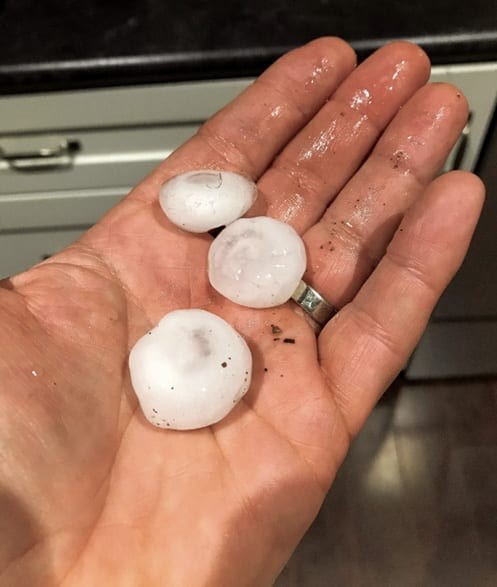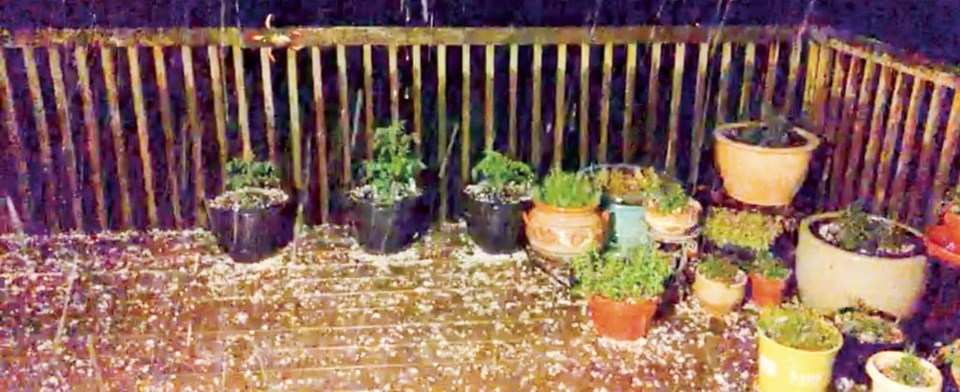Deluge of rain and hail cuts destructive swath through local farms and orchards
When Linda Allison saw the lightning across Lake Ontario and realized a major storm was brewing, she feared the worst for her cherry farm on Memorial Drive in Fenwick.
“Once it hit Vineland and Jordan with thumbnail size hail I knew we were in for it!”
The storm, when it hit Pelham, produced hail the size of golf balls that, though quite localized, devastated tender fruit and vegetable crops northeast of Fenwick.
When the storm passed, green cherries littered the ground in Allison’s orchard and those that remained on the trees bore black bruises and will fall off before they mature.
“I am sure the damage is worse on the tops of the trees, I’ve only looked tractor level,” she said.
Add the hail disaster to an already depleted crop due to the frost in mid-May, and the sour cherry crop this year will be minuscule according to a discouraged Allison.
“A damaged crop like this will need all the care and expense of a normal crop and will become juice— not cherries in a pail for your cherry pie pleasure.”
Her neighbour, Zack Haist, was hit just as hard. His sweet cherries were about half a normal crop due to the killer frost in May, and the hail finished the job begun by the cold. He estimates his income this year will be around a quarter of what it was last year, even though he has a more diversified fruit crop than Allison. What is left of the cherries will go into juice at $.35 a pound instead of the almost $2.00 a pound he would get for whole cherries.
And then there is his crop of plums.
“I was really excited we made it through the frost,” said Haist, “and then the hail came.”

His early golden plums are gone, 100 percent destroyed. He hopes his apples will provide better news and so far he has seen only moderate damage, but it will be several weeks before he’ll be able to really assess the health of the crop.
Further west on Memorial, Lee Johnson’s operation is even more diversified, but the storm did not spare his crops. His son, Nate, said that the nectarines and peaches in their orchards suffered a major hit and those that weren’t smashed to the ground will be bruised. Fortunately, peaches need to be thinned before they get mature, so selective thinning can cull out the most damaged fruit and save much of the crop, but that’s a labour-intensive process. Still, the Johnsons will have to sell many of their peaches as “seconds” due to the blemishes and scars left by the hail.
Even their potato crop did not escape. The torrential rain that accompanied the hail washed the Johnsons’ newly planted potatoes downhill and flooded their fields, mixing the varieties so that they will all have to be hand-sorted before they can be sold. His corn seedlings were killed by the repeated frost in May.
“The plants can survive one night of frost if there is any life left, but two nights of frost and they’re gone.”

Pelham experienced almost a week of nights with frost from May 8 to 13. Johnson was able to replant, but his crop is two weeks behind where it should be.
At the DeVries Fruit Farm, on Canboro Road, Dan DeVries figured that he lost 20 to 30 percent of his peaches and strawberries to the frost, and the hail took another 20 percent. He noted that for him it was fortunate that the hail came in large stones because smaller, more intense hailstones would have damaged more fruit. The big stones severely damaged anything they hit, but they didn’t hit as much as smaller hail. Still, he said, “I’ve never seen hail like that.” However, with selective thinning of the peaches, he declared, “We’ll have a viable crop.” And on the bright side, he noted that “sales have been really good in the Fenwick store. People have come out to support local.” A steady stream of customers and a lineup outside the entrance to his market on Saturday proved the truth of his words.
The frost and hail were only two of the problems facing local farmers this year. Add the shortfall in offshore workers, and producers will be hard-pressed to harvest whatever crops they manage to bring to maturity. Lee Johnson now has six of the usual 17 Mexican workers he needs. He said the shortage of labour means some crops didn’t get in the ground, and, “I’ve been on the tractor ten hours a day for the last two weeks, and Nate has been putting in 13- and 14-hour days.”
DeVries now has 19 of his normal complement of 24 offshore workers, but again their late arrival due to the required 14-day quarantine has set his schedule back. Zack Haist, until the weekend, had only one of his offshore helpers, but two more are about to come out of quarantine so he’ll have half of his normal six workers for the rest of the season.
And if hail and frost and worker shortages weren’t enough, many of the markets that farmers rely upon to sell their produce are closed due to the lockdown. While some markets like Niagara Falls and Milton are now beginning to open, Welland, Waterdown, and Port Colborne have not announced plans to reopen and the restrictions in place have lowered numbers of shoppers at the markets that are operating. Pelham’s Farmers Market opens tomorrow, June 11, with limited vendors.
As Zack Haist says with casual understatement, “It has been an interesting year.” De Vries and Johnson echo this “it is what it is” attitude and express confidence about next year.
“There are lots of people with bigger problems,” Dan DeVries summed it up.
You wouldn’t be a farmer if you weren’t an optimist.


